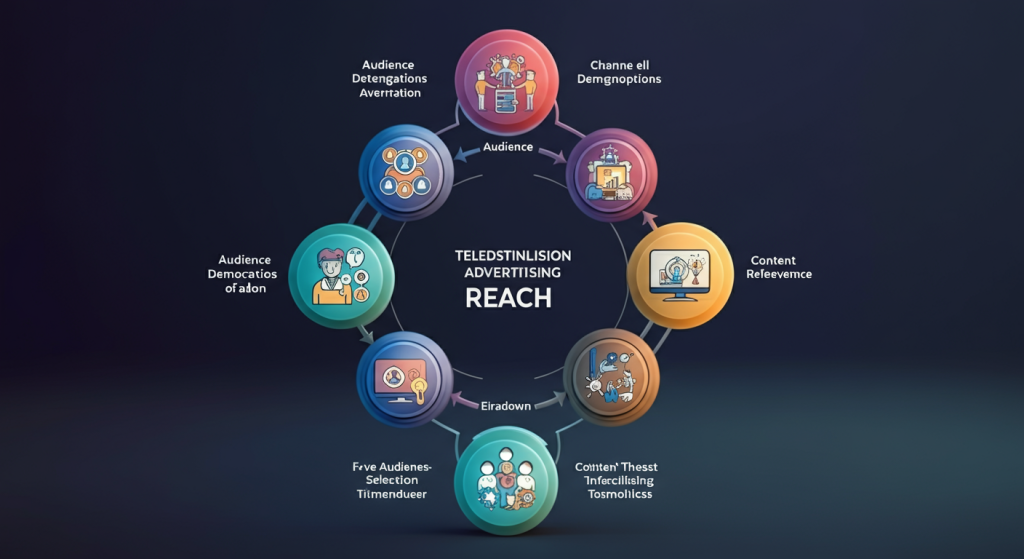Television advertising remains one of the most powerful marketing channels available to businesses today. Despite the rise of digital platforms, TV ads continue to capture massive audiences and influence purchasing decisions across demographics. But just how many consumers are reached using television advertisements, and what makes this medium so effective?
Understanding television’s reach is crucial for marketers planning their advertising strategies. From prime-time slots that attract millions of viewers to targeted cable programming that reaches specific demographics, television offers unparalleled access to consumers. This comprehensive guide explores the scope of television advertising reach, the factors that influence viewership, and how businesses can leverage this medium effectively.
The Scale of Television Advertising Reach
Television advertising reaches an extraordinary number of consumers daily. According to industry data, the average American watches over 2.5 hours of television per day, creating countless opportunities for advertisers to connect with their target audiences.
Daily Television Viewership Numbers
On any given day, television programming reaches approximately 280 million Americans. This massive audience represents roughly 85% of the total U.S. population, making television one of the most comprehensive mass media channels available.
Prime-time television slots, typically between 8 PM and 11 PM, consistently attract the largest audiences. During these hours, major networks can reach between 8 to 12 million viewers per program. Special events and popular shows can draw even larger audiences, with some programs reaching over 100 million viewers.
Weekly and Monthly Reach Statistics
The weekly reach of television advertising extends even further. Studies show that television advertising reaches over 90% of American adults each week. This weekly penetration rate remains remarkably consistent across different demographic groups, though viewing patterns and preferred content vary significantly.
Monthly television reach approaches near-universal coverage, with 95% of American households watching television at least once per month. This extensive reach provides advertisers with multiple opportunities to connect with consumers through repeated exposure and varied programming options.
Factors Influencing Television Advertising Reach
Several key factors determine how many consumers are reached using television advertisements. Understanding these elements helps advertisers optimize their campaigns for maximum impact and efficiency.

Time of Day and Scheduling
Television viewership fluctuates dramatically throughout the day. Morning programming typically attracts 2 to 4 million viewers, while daytime shows reach similar numbers but with different demographic compositions. Evening programming sees the highest viewership, with prime-time slots commanding premium advertising rates due to their superior reach.
Late-night television offers unique opportunities to reach specific demographics, particularly younger viewers who consume content during non-traditional hours. Weekend programming often provides different reach patterns, with sports programming delivering substantial male viewership and family-oriented content attracting broader audiences.
Program Genre and Content Type
Different television genres attract varying audience sizes and demographics. News programming consistently draws large, engaged audiences, particularly during major events or breaking news situations. Sports programming delivers some of the highest viewership numbers, with major sporting events reaching tens of millions of viewers simultaneously.
Entertainment programming, including scripted dramas and comedies, provides consistent reach across multiple demographics. Reality television shows often generate significant viewership among specific age groups, while educational and documentary programming attracts smaller but highly engaged audiences.
Network Type and Distribution
Broadcast networks traditionally reach the largest audiences, with major networks like ABC, CBS, NBC, and Fox commanding substantial viewership. Cable networks offer more targeted reach, allowing advertisers to connect with specific demographic groups or interest-based communities.
Streaming services have introduced new complexities to television advertising reach. While traditional broadcast and cable television still dominate overall reach numbers, streaming platforms are rapidly growing their audience share, particularly among younger demographics.
Demographic Variations in Television Reach
Television advertising reach varies significantly across different demographic groups. Understanding these variations helps advertisers develop more effective targeting strategies and optimize their media budgets.
Age-Based Reach Patterns
Television reach remains strong across all age groups, but consumption patterns differ markedly. Adults aged 50 and older watch significantly more television than younger demographics, with this group representing the heaviest television consumers.
Viewers aged 18 to 34 watch less traditional television but still represent a substantial portion of the overall audience. This demographic increasingly combines traditional television viewing with streaming services, creating new opportunities for advertisers to reach them across multiple platforms.
Children and teenagers represent a unique television audience with specific viewing patterns and preferences. This demographic often watches television during after-school hours and weekends, creating targeted opportunities for advertisers focusing on youth markets.
Geographic Distribution
Television advertising reach varies by geographic region and market size. Major metropolitan areas typically offer the largest potential audiences, with cities like New York, Los Angeles, and Chicago providing access to millions of viewers within single markets.
Rural areas often have different television viewing patterns, with local programming and specific network preferences influencing reach potential. Regional programming can provide excellent opportunities for businesses targeting specific geographic markets.
Measuring Television Advertising Effectiveness
Understanding how many consumers are reached using television advertisements requires sophisticated measurement techniques. Modern audience measurement combines traditional methods with advanced analytics to provide comprehensive reach data.
Traditional Ratings and Share Metrics
Television ratings remain the primary method for measuring audience reach. A single rating point represents approximately 1.28 million households, providing a standardized way to compare reach across different programs and time slots.
Share metrics indicate the percentage of active television viewers watching a particular program. High share numbers suggest strong audience engagement and effective reach within the active viewing population.
Advanced Analytics and Cross-Platform Measurement
Modern television measurement incorporates digital viewing, time-shifted viewing, and cross-platform consumption. These advanced metrics provide more accurate pictures of total reach, including viewers who watch content through various devices and platforms.
Real-time analytics allow advertisers to monitor reach as it happens, enabling rapid adjustments to campaigns and optimization of advertising spend. These tools provide unprecedented insight into audience behavior and reach effectiveness.
Maximizing Television Advertising Reach
Businesses can employ several strategies to maximize how many consumers are reached using television advertisements. These approaches focus on strategic planning, creative execution, and media optimization.
Strategic Time Slot Selection
Choosing the right time slots significantly impacts reach potential. Prime-time slots offer maximum reach but command premium prices. Advertisers with limited budgets can achieve substantial reach through strategic scheduling during shoulder periods or targeted programming.
Seasonal considerations also affect reach potential. Holiday periods often see increased television viewing, while summer months typically experience reduced audiences. Planning campaigns around these patterns can optimize reach and cost-effectiveness.
Creative Content Optimization
Compelling creative content encourages viewers to pay attention and remember advertisements. High-quality creative work can extend effective reach by generating word-of-mouth discussion and social media engagement.
Tailoring creative content to specific programs or audiences can improve engagement rates, effectively increasing the value of reach by ensuring advertisements resonate with viewers.
The Future of Television Advertising Reach
Television advertising continues evolving as technology and viewing habits change. Understanding these trends helps businesses prepare for future opportunities and challenges in reaching consumers through television.

Streaming Integration and Addressable TV
Connected TV and streaming platforms are creating new opportunities for television advertising reach. These platforms combine television’s visual impact with digital advertising’s precision targeting capabilities.
Addressable television advertising allows for household-level targeting while maintaining television’s broad reach capabilities. This technology enables advertisers to deliver different messages to different households watching the same program.
Cross-Platform Measurement Evolution
Future television advertising measurement will likely incorporate more sophisticated cross-platform analytics. These systems will provide clearer pictures of total reach across traditional television, streaming services, and digital platforms.
Advanced measurement will help advertisers understand how many consumers are reached using television advertisements across all viewing platforms, enabling more effective campaign planning and optimization.
Leveraging Television’s Unmatched Reach
Television advertising continues to reach more consumers than any other single advertising medium. With over 280 million Americans watching television daily and weekly reach exceeding 90% of adults, television provides unparalleled access to mass audiences.
Success in television advertising requires understanding audience patterns, demographic variations, and measurement techniques. By strategically planning campaigns, optimizing creative content, and leveraging advanced measurement tools, businesses can maximize their television advertising reach and achieve superior marketing results.
The question isn’t whether television advertising reaches consumers—it’s how businesses can best leverage this massive reach to achieve their marketing objectives. With proper planning and execution, television advertising continues to deliver exceptional value for businesses seeking to connect with large, engaged audiences.
Television advertising still reaches millions of consumers, offering broad exposure across diverse audiences. On the other hand, referral link marketing takes a more targeted, performance-based approach to customer acquisition. Understanding how both traditional and referral-driven methods work can help you build a balanced strategy that combines reach with measurable results





